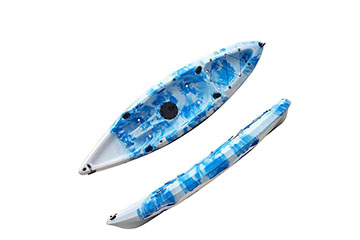How to Paddle the Kayak Correctly?
1. How to row the kayak correctly?
1.1. Straight stroke. Tilt your right body forward about 30-45 degrees and extend the right oar to the front right. Insert the oar into the water approximately near the toes, and pull it back along the hull until it comes out of the water approximately behind the hip. While the right oar is pulled out of the water, tilt the left body forward about 30-45 degrees and extend the left oar to the front left, insert the oar into the water about the toe, and pull it back along the hull to about the hip Then pull it out of the water.
1.2. Back stroke. Insert the right oar into the water about the hip, and push it back along the hull until it is pulled out of the water about the knee. While the right oar is pulled out of the water, insert the left oar about the hip into the water and push it back along the hull until it is pulled out of the water about the knee.
1.3. Front sweep.
Left: Turn the body to the left as far as possible, and look at the target to be turned (try looking at the stern on your left in the practice), extend the right oar to the front right, insert the oar into the water approximately near the toe, and move along the hull Pull back to the surface approximately behind the hips.
The operation on the right is the same as the operation on the left, but the action is opposite.

2. What are the classifications of professional fishing kayak?
Fancy boat. Fancy boat A relatively small canoe with small volume and short length, suitable for fancy movements.
Whitewater boat. The volume of the body is relatively large, which is more suitable for the exploration of down stream or short-range river.
Ocean boat. The hull is slender, generally more than 4 meters, with a rudder, easy to control the direction, suitable for long-distance travel.
Short-distance travel boats. The hull is large and stable, suitable for short-distance travel of novices.
Platform canoe. Most of them are used for leisure, and many surf boats are platform boats.
Fishing boat. A leisure boat specially designed for fishing enthusiasts, with fishing racks, bait boxes, anchor racks, etc. added.
3. What is the difference between rowing and kayaking?
There are two most obvious differences between rowing and kayaking.
First, the rowing athletes paddle their backs to the forward direction; secondly, the rowing boat is equipped with oars on the side of the boat, but the kayaks do not. In addition, rowers sit on seats equipped with four wheels to participate in the competition.
The levels are divided into men’s and women’s open class and women’s lightweight. Kayak is generally facing the forward direction, while rowing is facing the forward direction.
What are the benefits of kayaking for the body?
Kayaks is an outdoor sport and a test of speed and endurance. Frequent participation in kayaking can promote the regulation of human cardiovascular function, increase lung capacity, and enhance body muscle strength and endurance. It is a fitness exercise. Good project. At the same time, because it is water sports, the content of negative ions on the water is 2 to 3 times that of indoor sports, which is also of great benefit to the respiratory system. Kayaking is an aerobic exercise. Regular participation in kayaking can effectively enhance the functions of the cardiovascular system and respiratory system, increase lung capacity, and develop body muscle strength and endurance. Men often kayaking can effectively exercise the deltoid, pectoralis major, rectus abdominis and trapezius muscles. Women's body curves will be more perfect with proper exercises.
What to pay attention to when doing professional touring kayak?
1. The kayak may be difficult to see from a distance, especially on the sea. Please try to wear bright clothes and carry signal equipment.
2. As with vehicles, keep to the right when rowing.
3. If there are larger ships nearby, please stay away from them as much as possible.
4. Buoys: If there are buoys in the waters indicating forward or prohibited areas, please follow the instructions.
5. You must wear a life jacket and choose according to your weight. Not only can you float when you fall into the water, but you can also keep your body temperature.
6. You must carry a whistle, which can not only call for help, but also warn when a large ship approaches.










